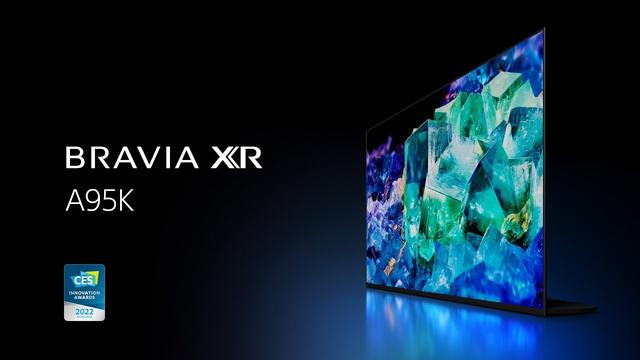Sony is setting some pretty grand expectations with its 2022 TV lineup — led by the introduction of the world’s first consumer QD-OLED TV. The company’s current and well-regarded OLED sets use panels from LG Display that are tuned with Sony’s own processing. But the new flagship Bravia XR A95K TV will include a QD-OLED (quantum dot organic light emitting diode) panel manufactured by none other than Samsung Display. It’ll come in 65-inch and 55-inch sizes, with both coming in at 4K resolution.
It was rumored that Samsung Electronics might announce a QD-OLED 4K TV at CES 2022, but that hasn’t panned out so far. So it’s Sony that gets the prime spotlight instead. Samsung Display has been developing QD-OLED for a number of years, and the display technology could become something of a middle step between standard OLED and the MicroLED displays that only Samsung is selling right now — for ungodly sums of money.
QD-OLED is designed to combine the best traits of OLED (perfect blacks, infinite contrast, etc.) with benefits of quantum dot LED TVs like improved brightness and more vivid color reproduction at higher brightness levels. It’s not a major new approach like Micro LED, but more of a progression from where things have stood for a few years.
What’s the difference between OLED and QD-OLED?
QD-OLED screens differ from the traditional OLED panels that’ve long been manufactured by LG Display in the way they produce an image. LG’s displays are considered WRGB OLED, because they use blue and yellow OLED compound to generate white-ish light pixels that are passed through color filters to produce red, green, and blue sub-pixels. More recent OLED TVs also have a fourth unfiltered / white sub-pixel meant to enhance brightness — especially for HDR content.

QD-OLED changes this up by emitting blue light through quantum dots to convert some of that blue into red and green without any need for the color filter. (Blue is used because it has the strongest light energy.) This leads to greater light energy efficiency; since you’re not losing any light to the color filters, QD-OLED TVs should offer brightness gains compared to past-generation OLEDs.
They should also be able to maintain vivid quantum dot color reproduction even at peak brightness levels, whereas WRGB OLED can sometimes exhibit some desaturation when pushed that far. In Sony’s case, the company is claiming that QD-OLED “boosts color brightness by up to 200 percent compared to conventional TVs.” The already-superb viewing angles of OLED are claimed to be even better on QD-OLED since there’s more diffusion happening without the color filter in the way.
The possibility of burn-in isn’t eliminated by QD-OLED, but the hope is that these panels could exhibit a longer overall life span than existing OLED TVs since the pixels aren’t working as hard. Samsung Display is using three layers of blue OLED material for each pixel, and that could preserve their longevity.
Sony is still sourcing from LG Display for its other 2022 OLEDs, the A90K and A80K, so that business relationship isn’t going anywhere. But the company now finds itself in the unique position of having two different types of OLED TVs. It’ll be very interesting to see the head-to-head comparisons between QD-OLED and the best “normal” OLED sets from LG and Sony once they all start shipping to consumers this spring.
Aside from its one-of-a-kind panel, the A95K comes with a unique stand that can either put the TV in a “front position” style, where the display is in front of the stand, or a “back position” if you want to position the pricey TV right up against a wall. The back of the TV also has a funky look to it that I can appreciate with built-in cable management. Even the step-down A90K OLED’s stand has a trick where it can raise the display enough for a soundbar to rest on it without obstructing the view.
The A95K will have four HDMI inputs, with two of them having full HDMI 2.1 capabilities. All of Sony’s latest OLEDs will support 4K gaming at 120Hz, auto HDR tone mapping when connected to a PS5, and auto low latency mode. And these TVs will finally ship with the option for variable refresh rate out of the box instead of making buyers wait for a software update like past models. Hopefully that’s a sign that VRR is coming closer to arriving on the PlayStation 5 itself.
Google TV remains Sony’s software of choice for 2022, and the lineup continues to feature the company’s word salad of branded features like XR OLED Contrast Pro, XR Triluminos Max (for the A95K) or Pro (for the rest), and Acoustic Surface Audio Plus. Sony really does get some fantastic audio performance from its premium TVs, and its in-house processing also slightly bests LG’s OLED lineup in picture quality, so the names are probably here to stay.
Sony also announced its first line of Micro LED TVs, which I’ve covered separately. Pricing and specific release dates for all the TVs will be announced in the coming months.









